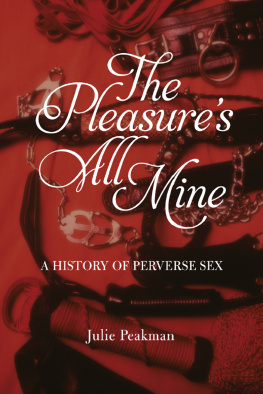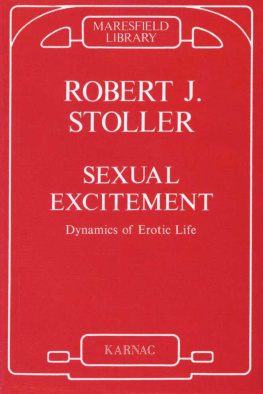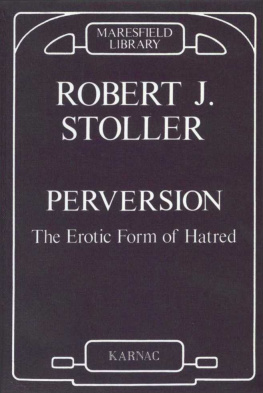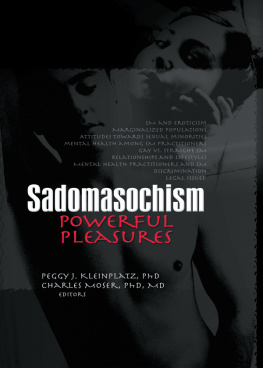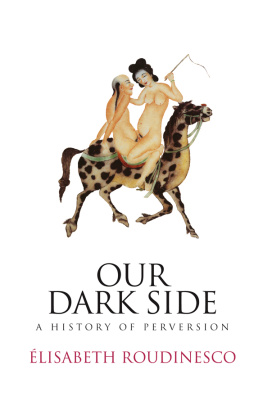Printed and bound in China by Toppan Printing Co. Ltd.
Introduction
O ne persons perversion is anothers normality. If we strip sex back to basics, we will find that most sexual acts have been deemed abnormal by someone at one time or another, while conversely, at different times those same sexual behaviours have been deemed acceptable by other groups of people. Previously unacceptable acts (what were thought of as the worst sexual behaviour imaginable) such perversions as incest, pederasty, sadomasochism and homosexuality are now acceptable to many people. Nearly every sexual activity that we are aware of today can be traced historically, although there are some decidedly modern types of sexual activity which have arisen as a result of new technology phone sex, cyber sex and video porn, to name a few.
The Pleasures All Mine examines the gamut of sexual activity that has been considered strange, abnormal or deviant over the last 2,000 years, and puts it into its cultural context, culminating with the modern-day understanding of sex. It shows how different sexual behaviours were constructed as perverse by religion and society, in law and medicine and argues that sexual behaviour is not in itself perverse, but only becomes so when perceived as such by certain groups in society, and that this perception changes over time.
People from different periods ancient Greece, ancient Rome, medieval, Renaissance and Enlightenment Europe through to Victorian and twentieth-century England all had different attitudes to sex. People from each time period had different ways of discussing, defining and codifying sex. Heterosexuality, homosexuality, lesbianism, bestiality, necrophilia and paedophilia had different meanings (or sometimes no meaning at all) for people in other times. That said and although many historians have argued that people from the past had a completely different viewpoint or world view many of the ideas around sex were also remarkably similar to those current today. It is the continuity, as well as the differences, which make human experiences so compelling in history. After all, sex is the one act we all share, even in its absence (for example, choosing chastity, being identified as a nun or a monk). Sex and sexuality are at the core of all human existence, and have been part of all human institutions and conventions religious, medical, political, societal and artistic.
My intention here then is to find sexual perversion before it was discovered by sexologists, before its labelling and phraseology, and to trace its development. I use the word perversions here in quotes because not all people agree on which acts are perverted, or have ever been perversions at all. When we look at terminology we step into a quagmire of phrases. Sexual perversions have been termed deviant acts, abnormal behaviour, acts against nature, unnatural acts, abominable vices and so on. There have been countless expressions for sexual acts that certain groups find unpalatable. At any one time, a particular phrase or word might be more commonly used to describe these various acts. As far as possible, in order to try to contextualize sexual behaviour within its own time, I use the specific words as they would then have been used the reason being that certain phrases carry historically specific nuances which need to be explained differences which may be difficult for us always to grasp. But I will also be using the term perversion as we use it now, and propose that the time has come for a change perhaps even an end to applying the word to any sexual behaviours (except in its historical context of nineteenth-century sexology, that is), since many of our past sexual perversions have become our present sexual normality.
Sexual perversions began to be categorized in depth by the sexologists only in the second half of the nineteenth century. Among them were Richard von Krafft-Ebing, Havelock Ellis, Albert Moll, Alfred Binet, Iwan Bloch, Magnus Hirschfeld, Sigmund Freud and many others. All contributed to the making of modern sexual perversity and realigned the division between the normal and the abnormal. This involved the labelling of the acts of sexual perversion and it was sexologists who were responsible for giving us our current-day identification of the acts (although attitudes about them have since shifted). However, many of these sexual behaviours existed long before their nametags. Each century had its own peculiarities, but sexual deviation is rooted in its historical climate.
Within the book, I look backwards to examine each so-called perversion from when it was first visible in history, through to its interpretation by sexologists, to see how it is viewed today. I have focused on Europe and the West, as there is simply too much information to include in a worldwide examination of sexual perversion. In any case, sexual perversions of the East bring in an entirely new dimension worthy of another book. Even with this restriction, there is a limited amount of information that can be included, and inevitably some topics have had to be covered broadly or simply not at all. I have attempted to include a wide enough range of examples to make my case. Through the examination of court records, personal letters, travelogues, medical advice literature, medical and criminal reportage, newspaper accounts, novels, erotica and films, I will reveal exactly how complicated our sexual behaviour is.
Sexual behaviour is difficult enough to trace in any circumstances. Much of it is carried out in private and therefore hidden from view. Where acts were deemed perverse, people were even more keen that their activities should not be known. Their activities were also often also deemed criminal and people did not want to suffer the consequences, particularly if being caught meant ostracization, flogging or death. Each source comes with its own limitations: court records only show us cases which came to trial; for every one of those, there may have been countless incidents which went unheeded or unexposed. They are also not recorded verbatim but reported through a third party, placing a further barrier between us and the witness or victim. Some deviant acts, such as lesbianism in medieval England, were not considered important enough to bring before the authorities so leave hardly any traces behind, although the ones we have are invaluable. Personal accounts, while offering more depth of feeling and opinion than court records, might not give us the popular viewpoint. Also, people dont tend to record all their sexual activities in journals. When they do, such as in the diaries of Anne Lister and Samuel Pepys, they are golden nuggets for historians. Even then, the parts of diaries that record sexual experiences were often written in code and have taken years of patient cryptography to decipher.

